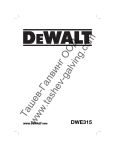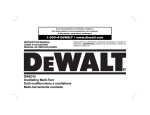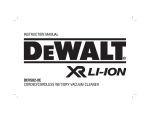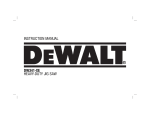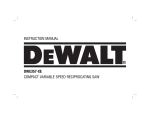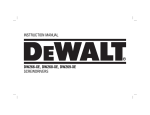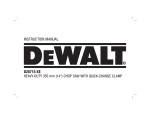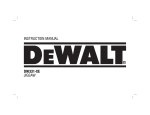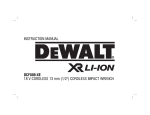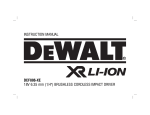Download DeWalt DWE315-XE Instruction manual
Transcript
INSTRUCTION MANUAL DWE315-XE OSCILLATING MULTI-TOOL Vibration total values (triax vector sum) determined according to EN 60745: Definitions: Safety Guidelines Vibration emission value ah ah = Uncertainty K = The definitions below describe the level of severity for each signal word. Please read the manual and pay attention to these symbols. DANGER: Indicates an imminently hazardous situation which, if not avoided, will result in death or serious injury. WARNING: Indicates a potentially hazardous situation which, if not avoided, could result in death or serious injury. CAUTION: Indicates a potentially hazardous situation which, if not avoided, may result in minor or moderate injury. NOTICE: Indicates a practice not related to personal injury which, if not avoided, may result in property damage. An estimation of the level of exposure to vibration should also take into account the times when the tool is switched off or when it is running but not actually doing the job. This may significantly reduce the exposure level over the total working period. Technical Data Voltage Power input Oscillating frequency Oscillating angle Weight V W min-1 kg LPA KPA LWA KWA dB(A) dB(A) dB(A) dB(A) 86 3 97 3 (sound pressure) (sound pressure uncertainty) (sound power) (sound power uncertainty) 16.1 1.5 The vibration emission level given in this information sheet has been measured in accordance with a standardised test given in EN 60745 and may be used to compare one tool with another. It may be used for a preliminary assessment of exposure. WARNING: The declared vibration emission level represents the main applications of the tool. However if the tool is used for different applications, with different accessories or poorly maintained, the vibration emission may differ. This may significantly increase the exposure level over the total working period. IF YOU HAVE ANY QUESTIONS OR COMMENTS ABOUT THIS OR ANY DEWALT TOOL, CALL US AT: 1800 338 002 (Aust) or 0800 339 258 (NZ). DWE315-XE 230 300 0 – 22000 1.6˚ 1.5 m/s² m/s² Identify additional safety measures to protect the operator from the effects of vibration such as: maintain the tool and the accessories, keep the hands warm, organisation of work patterns. SAFETY INSTRUCTIONS FOR POWER TOOLS When using power tools, always observe the safety regulations applicable in your country to reduce the risk of fire, electric shock and personal injury. Read the following safety instructions before attempting to operate this product. Keep these instructions in a safe place. WARNING: To reduce the risk of injury, user must read the instruction manual. GENERAL POWER TOOL SAFETY WARNINGS WARNING! Read all safety warnings and all instructions Failure to follow the warnings and instructions may result in electric shock, fire and/or serious injury. 1 SAVE ALL WARNINGS AND INSTRUCTIONS FOR FUTURE REFERENCE 3) PERSONAL SAFETY a) Stay alert, watch what you are doing and use common sense when operating a power tool. Do not use a power tool while you are tired or under the influence of drugs, alcohol or medication. A moment of inattention while operating power tools may result in serious personal injury. b) Use personal protective equipment. Always wear eye protection. Protective equipment such as dust mask, non-skid safety shoes, hard hat, or hearing protection used for appropriate conditions will reduce personal injuries. c) Prevent unintentional starting. Ensure the switch is in the off position before connecting to power source and/or battery pack, picking up or carrying the tool. Carrying power tools with your finger on the switch or energising power tools that have the switch on invites accidents. d) Remove any adjusting key or wrench before turning the power tool on. A wrench or a key left attached to a rotating part of the power tool may result in personal injury. e) Do not overreach. Keep proper footing and balance at all times. This enables better control of the power tool in unexpected situations. f) Dress properly. Do not wear loose clothing or jewellery. Keep your hair, clothing and gloves away from moving parts. Loose clothes, jewellery or long hair can be caught in moving parts. g) If devices are provided for the connection of dust extraction and collection facilities, ensure these are connected and properly used. Use of dust collection can reduce dust-related hazards. 4) POWER TOOL USE AND CARE a) Do not force the power tool. Use the correct power tool for your application. The correct power tool will do the job better and safer at the rate for which it was designed. b) Do not use the power tool if the switch does not turn it on and off. Any power tool that cannot be controlled with the switch is dangerous and must be repaired. c) Disconnect the plug from the power source and/or the battery pack from the power tool before making any adjustments, changing accessories, or storing power tools. Such preventive safety measures reduce the risk of starting the power tool accidentally. The term “power tool” in the warnings refers to your mains-operated (corded) power tool or battery-operated (cordless) power tool. 1) WORK AREA SAFETY a) Keep work area clean and well lit. Cluttered or dark areas invite accidents. b) Do not operate power tools in explosive atmospheres, such as in the presence of flammable liquids, gases or dust. Power tools create sparks which may ignite the dust or fumes. c) Keep children and bystanders away while operating a power tool. Distractions can cause you to lose control. 2) ELECTRICAL SAFETY a) Power tool plugs must match the outlet. Never modify the plug in any way. Do not use any adapter plugs with earthed (grounded) power tools. Unmodified plugs and matching outlets will reduce risk of electric shock. b) Avoid body contact with earthed or grounded surfaces such as pipes, radiators, ranges and refrigerators. There is an increased risk of electric shock if your body is earthed or grounded. c) Do not expose power tools to rain or wet conditions. Water entering a power tool will increase the risk of electric shock. d) Do not abuse the cord. Never use the cord for carrying, pulling or unplugging the power tool. Keep cord away from heat, oil, sharp edges or moving parts. Damaged or entangled cords increase the risk of electric shock. e) When operating a power tool outdoors, use an extension cord suitable for outdoor use. Use of a cord suitable for outdoor use reduces the risk of electric shock. f) If operating a power tool in a damp location is unavoidable, use a residual current device (RCD) protected supply. Use of an RCD reduces the risk of electric shock. 2 Extension Cords d) Store idle power tools out of the reach of children and do not allow persons unfamiliar with the power tool or these instructions to operate the power tool. Power tools are dangerous in the hands of untrained users. e) Maintain power tools. Check for misalignment or binding of moving parts, breakage of parts and any other condition that may affect the power tool’s operation. If damaged, have the power tool repaired before use. Many accidents are caused by poorly maintained power tools. f) Keep cutting tools sharp and clean. Properly maintained cutting tools with sharp cutting edges are less likely to bind and are easier to control. g) Use the power tool, accessories and tool bits, etc. in accordance with these instructions, taking into account the working conditions and the work to be performed. Use of the power tool for operations different from those intended could result in a hazardous situation. 5) SERVICE a) Have your power tool serviced by a qualified repair person using only identical replacement parts. This will ensure that the safety of the power tool is maintained. CAUTION: Use only extension cords that are approved by the country’s Electrical Authority. Before using extension cords, inspect them for loose or exposed wires, damaged insulation and defective fittings. Replace the cord if necessary. Tool Safety Warnings • Hold power tool by insulated gripping surfaces, because the belt may contact its own cord. Contact with a "live" wire may make exposed metal parts of the power tool "live" and could give operator an electric shock. • Use clamps or another practical way to secure and support the workpiece to a stable platform. Holding the work by hand or against your body leaves it unstable and may lead to loss of control. • Air vents often cover moving parts and should be avoided. Loose clothes, jewellery or long hair can be caught in moving parts. WARNING: We recommend the use of a residual current device with a residual current rating of 30mA or less. WARNING: ALWAYS wear approved protective safety equipment complying with the following standards: • Eye protection: AS/NZS1337 Eye Protectors for Industrial Applications; • Hearing protection: AS/NZS1270 Acoustics – Hearing Protection; • Respiratory protection: AS/NZS1716 Respiratory Protective Devices. WARNING: Some dust created by power sanding, sawing, grinding, drilling, and other construction activities contains chemicals known to cause cancer, birth defects or other reproductive harm. Some examples of these chemicals are: • lead from lead-based paints, • crystalline silica from bricks and cement and other masonry products, and • arsenic and chromium from chemically-treated lumber. Your risk from these exposures varies, depending on how often you do this type of work. To reduce your exposure to these chemicals: work in a well ventilated area, and work with approved safety equipment, such as those dust masks that are specially designed to filter out microscopic particles. Electrical Safety The electric motor has been designed for one voltage range only. Always check that the power supply corresponds to the voltage on the rating plate. 220–240 V AC means your tool will operate on alternating current. Operation at a voltage outside this range can cause loss of power and can result in overheating. All DEWALT tools are factory tested; if this tool does not operate, check the power supply. Your DEWALT tool is double insulated, therefore no earth wire is required. • Young children and the infirm. This appliance is not intended for use by young children or infirm persons without supervision. – This appliance is not intended for use by persons (including children) with reduced physical, sensory or mental capabilities, or lack of experience and knowledge, unless they have been given supervision or instruction concerning use of the appliance by a person responsible for their safety. – Children should be supervised to ensure that they do not play with the appliance. • Replacement of the supply cord. If the supply cord or plug is damaged, it must be replaced by the manufacturer or an authorised DEWALT Service Centre in order to avoid a hazard. 3 COMPONENTS (FIG. 1) • Avoid prolonged contact with dust from power sanding, sawing, grinding, drilling, and other construction activities. Wear protective clothing and wash exposed areas with soap and water. Allowing dust to get into your mouth, eyes, or lay on the skin may promote absorption of harmful chemicals. WARNING: Use of this tool can generate and/or disburse dust, which may cause serious and permanent respiratory or other injury. Always use AS/NZS1716 approved respiratory protection appropriate for the dust exposure. Direct particles away from face and body. WARNING: Always wear proper personal hearing protection that conforms to AS/NZS1270 during use. Under some conditions and duration of use, noise from this product may contribute to hearing loss. • The label on your tool may include the following symbols. The symbols and their definitions are as follows: V .................... volts A .................... amperes Hz .................. hertz W ................... watts min ................ minutes or AC ....... alternating current or DC .. direct current or AC/DC . alternating or direct current ................. Class I Construction no ................... no load speed ...................... (grounded) n..................... rated speed ................. Class II Construction .................. earthing terminal ...................... (double insulated) ................... safety alert symbol …/min ........... per minute BPM ............... beats per minute IPM ................ impacts per minute RPM ............... revolutions per minute OPM............... oscillations per minute sfpm ............... surface feet per minute WARNING: Never modify the power tool or any part of it. Damage or personal injury could result. A. Variable speed trigger E. Accessory side mount B. LED Worklight F. Cut guide block C. Accessory clamp lever G. Cut guide arm D. Lock-on button FIG. 1 B D A C E F G SAVE ALL WARNINGS AND INSTRUCTIONS FOR FUTURE REFERENCE INTENDED USE This oscillating multi-tool is designed for professional detail sanding, plunge cutting, flush cutting, removal of excess materials and surface preparation applications. DO NOT use under wet conditions or in presence of flammable liquids or gases. This oscillating multi-tool is a professional power tool. DO NOT let children come into contact with the tool. Supervision is required when inexperienced operators use this tool. 4 ASSEMBLY AND ADJUSTMENTS INSTALLING/REMOVING SANDING FIG. 5 SHEETS (FIG. 5) A diamond shaped platen uses a hook and loop adhesion system to attach the sanding sheets. J The platen allows you to use it on large flat surfaces and tight spots or corners. 1. Attach the sanding platen (I) as described under Installing/Removing Accessories. 2. Align the edges on the sanding sheet, with the edge of the sanding platen and press the sanding sheet (J) onto the platen. 3. Firmly press the base with the sanding sheet attached against a flat surface and briefly I switch the tool on. This provides for good adhesion between the platen and the sanding sheet and also helps to prevent premature wear. 4. When the tip of the sanding sheet becomes worn, detach the sheet from the platen, rotate and reapply. ATTACHING ACCESSORIES USING THE UNIVERSAL ADAPTER (FIG. 6) Non-DEWALT accessories can be attached using the universal adaptor. 1. Place the washer (K) on the tool. FIG. 6 2. Place accessory on to washer. 3. Tighten and secure adaptor nut (L) using hex wrench (P). CAUTION: To avoid injury, do not use any accessory for an application where the adaptor may fail to hold the accessory. WARNING: To reduce the risk of serious personal injury, turn tool off and disconnect tool from power source before making any adjustments or removing/ installing attachments or accessories. An accidental start-up can cause injury. WARNING: Risk of lacerations or burns. Do not touch workpiece or blade immediately after operating the tool. They can become very hot. Handle carefully. Always allow accessories and workpiece to cool before handling. Installing/Removing Accessories (Fig. 2–4) TOOL-FREE ACCESSORY CLAMP FIG. 2 The DWE315 features a quick change accessory system. This allows for faster accessory changes without the need for wrenches or hex keys like other oscillating tool systems. 1. Grasp the tool and squeeze the accessory clamping lever (C) as shown in Figure 2. H 2. Clean any residual debris from the tool shaft C and the accessory holder. 3. Slide the accessory between the shaft (H) and the accessory holder making sure the accessory engages all eight pins on the holder and is flush with the shaft. 4. Release the accessory clamp lever. NOTE: Some accessories, such as scrapers and blades can be mounted at an angle if required as shown in Figure 4. FIG. 3 FIG. 4 L 5 K CUT GUIDE This feature allows you to more accurately track a marked cut line. 1. Insert the guide arm (G) as shown in figure 10 into the slots on the left and right sides of the guide block (F). 2. Adjust the length of the guide by pulling out or pushing inward to achieve the desired length as shown in Figure 11. 3. Secure the guide in place by turning the depth/cut adjustment knob (N) clockwise. To release the guide turn the depth/cut adjustment knob counterclockwise. NOTE: The cut guide block and the cut guide arm are available on selected model only. CAUTION: Read and follow all manufacturers' safety warnings for any accessories used with this tool. CAUTION: To avoid injury, ensure adaptor and accessory are securely tightened. Attaching the Cut Guide (Fig. 7–12) FIG. 7 The depth/cut guide allows you to precisely cut material at a specified depth and more accurately E track a marked cut line. 1. Attach the cut guide block (F) by inserting the tabs (M) on the guide into the accessory side mount (E) on the main body of the tool. 2. Secure the block to the main body with the supplied screw (O). Tighten with the supplied hex wrench (P). F DEPTH GUIDE This feature allows you to precisely cut material at a specified depth. 1. Insert the guide arm (G) as shown in Figure 8 into the front slot on the guide block (F). P 2. Adjust the length of the guide by pulling out or pushing inward to achieve the desired cut depth as shown in Figure 9. 3. Secure the guide in place by turning the depth/cut adjustment knob (N) clockwise. To release the guide turn the depth/cut adjustment knob counterclockwise. M FIG. 10 O F G NOTE: The guide arm can also be placed in the guard assembly vertically in order to set the height off a cut. Refer to Figure 12. Attaching the Dust Extraction Adaptor (Fig. 13) F G N FIG. 12 The Dust Extraction Adaptor allows you to connect the tool to an external dust extractor, either using the AirLock™ system (DWV9000-XJ) or a standard 35 mm dust extractor fitment. 1. Attach the dust extraction adaptor (Q) by inserting the tabs (M) in to the accessory side mount slots (E). 2. Insert screw (O) and washer (R) into the dust extraction adaptor (Q) and tighten with the supplied hex key (P). FIG. 9 FIG. 8 FIG. 11 N 6 Using the Dust Extraction Adaptor with Plunge Cutting Accessory (Fig. 15) NOTE: The dust extraction adaptor is available on selected model only. Q FIG. 13 1. Attach the dust extraction adaptor. Refer to Attaching the Dust Extraction Adaptor. 2. Push dust extraction arm (R) into the lower aperture of the dust extraction adaptor (Q). 3. Attach plunge cutting bit as described under Installing/Removing Accessories. 4. Adjust the dust extraction arm (R) for best results. M P O R WARNING: Ensure switch is fully OFF before plugging in the power cord. 1. Plug in power cord. 2. To turn the tool ON, hold it as shown in FIG. 16 Figure 14 and press the variable speed trigger (A). NOTE: The further the trigger switch is depressed the faster the tool will operate. If in doubt about the proper speed for your operation, test the performance at low speed and A gradually increase until a comfortable speed is found. 3. To turn the tool OFF, release the variable speed switch (A). OPERATION WARNING: To reduce the risk of serious personal injury, turn tool off and disconnect tool from power source before making any adjustments or removing/ installing attachments or accessories. An accidental start-up can cause injury. Proper Hand Position (Fig. 14) WARNING: To reduce the risk of serious personal injury, ALWAYS use proper hand position as shown in Figure 14. WARNING: To reduce the risk of serious personal injury, ALWAYS hold securely in anticipation of a sudden reaction. 1. Attach the dust extraction adaptor (Q). Refer to Attaching the Dust Extraction Adaptor. 2. Attach the sanding platen (I) as described under Installing/Removing Accessories. 3. Attach sanding sheet as described under Installing/ Removing Sanding Sheets. Q Variable Speed Trigger (Fig. 16) E Using the Dust Extraction Adaptor with the Sanding Platen (Fig. 14) FIG. 15 FIG. 14 Q Lock-on Button (Fig. 17) FIG. 17 For more comfort in extended use applications, the lock-on button (D) can lock the trigger switch (A) in the depressed position. I D A 7 LED Worklight (Fig. 18) MAINTENANCE The LED worklight (B) will activate when the trigger is depressed. WARNING: To reduce the risk of serious personal injury, turn tool off and disconnect tool from power source before making any adjustments or removing/ installing attachments or accessories. An accidental start-up can cause injury. FIG. 18 Lubrication Your power tool requires no additional lubrication. B Cleaning WARNING: Blow dirt and dust out of all air vents with clean, dry air at least once a week. To minimize the risk of eye injury, always wear AS/NZS1337 approved eye protection when performing this. WARNING: Never use solvents or other harsh chemicals for cleaning the non-metallic parts of the tool. These chemicals may weaken the plastic materials used in these parts. Use a cloth dampened only with water and mild soap. Never let any liquid get inside the tool; never immerse any part of the tool into a liquid. Helpful Hints • Always ensure the workpiece is firmly held or clamped to prevent movement. Any movement of the material may affect the quality of the cutting or sanding finish. • Do not start sanding without having the sandpaper attached to sanding platen. • Use coarse grit paper to sand rough surfaces, medium grit for smooth surfaces and fine grit for the finishing surfaces. If necessary, first make a test run on scrap material. • Excessive force will reduce the working efficiency and cause motor overload. Replacing the accessory regularly will maintain optimum working efficiency. • Do not allow the sandpaper to wear away, it will damage the sanding pad. • If the tool overheats, especially when used at low speed, set the speed to maximum and run it with no load for 2–3 minutes to cool the motor. Avoid prolonged usage at very low speeds. Always keep the blade sharp. Repairs To assure product SAFETY and RELIABILITY, repairs, maintenance and adjustment (including brush inspection and replacement) should be performed by certified service centers or other qualified service organizations, always using identical replacement parts. Accessories WARNING: Since accessories, other than those offered by DEWALT, have not been tested with this product, use of such accessories with this tool could be hazardous. To reduce the risk of injury, only DEWALT recommended accessories should be used with this product. Recommended accessories for use with your tool are available at extra cost from your local service center. If you need any assistance in locating any accessory, please contact Stanley Black & Decker, 82 Taryn Drive, Epping, VIC 3076 Australia or call 1800 338 002 or (NZ) 0800 339 258. 8 Troubleshooting Problem Possible Cause Possible Solution Unit will not start. Cord not plugged in. Plug tool into a working outlet. Circuit fuse is blown. Replace circuit fuse. (If the product repeatedly causes the circuit fuse to blow, discontinue use immediately and have it serviced at an authorized service center.) Circuit breaker is tripped. Reset circuit breaker. (If the product repeatedly causes thecircuit breaker to trip, discontinue use immediately and have it serviced at an authorized service center.) Cord or switch is damaged. Have cord or switch replaced at an authorized service center. 9 Stanley Black & Decker 82 Taryn Drive, Epping, VIC 3076 Australia • 1800 338 002 (Aust) or 0800 339 258 (NZ) www.dewalt.com.au • www.dewalt.co.nz (JUN13) Part No. N289479 DWE315-XE Copyright © 2013 DEWALT The following are trademarks for one or more DEWALT power tools: the yellow and black color scheme; the “D” shaped air intake grill; the array of pyramids on the handgrip; the kit box configuration; and the array of lozenge-shaped humps on the surface of the tool.












